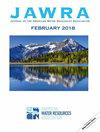Assessment of Water Quality using Water Quality Index in Jhapjhapia River, Khulna, Bangladesh
IF 2.6
4区 环境科学与生态学
Q3 ENGINEERING, ENVIRONMENTAL
引用次数: 1
Abstract
In southwest coastal Bangladesh, surface water is a crucial basis both for domestic and irrigation purposes. This study investigated the water quality of the Jhapjhapia River, Khulna, Bangladesh using the Water Quality Index (WQI). For many purposes like agriculture, fish farming, and household and industrial activities, surrounding people depend on these water sources. Hence, this study examined the physico-chemical attributes and Weighted Arithmetic Water Quality Index (WAWQI) of three (03) different stations, collected during the monsoon and winter seasons. Among the investigated parameters, ten (10) crucial parameters were considered for the evaluation of water quality. Throughout the research period, the pH value ranges from 7.65 to 7.79. From Station-1 to Station-3, the concentration of EC, TDS, and DO was steadily reduced (Station-1>Station-2>Station-3). The analytical results found that the water transparency ranged from 5 to 10 cm while BOD ranged from 1.85 to 2.71 mg/l and 1.79 to 2.75 mg/l in the monsoon and winter seasons respectively. The levels of total hardness varied from 95 mg/l to 160 mg/l and 130 mg/l to 225 mg/l whereas total alkalinity ranged from 108 to 140 mg/l throughout the monsoon and winter season. Similarly, Ca 2+ value ranged from 24.71 to 28.05 mg/l and 34.74 mg/l to 42.01 mg/l and Mg 2+ ranged from 10.93 to 6.07 mg/l and from 5.93 mg/l to 8.56 mg/l correspondingly. The overall WQI value is found between 51 to 75, demonstrating the status of water quality is poor (Grade-C), unhealthy for drinking without proper treatment though can be used for irrigation and industrial purposes till now. Therefore, this study seeks appropriate strategic initiatives and conservation measures with proper monitoring to stop the deterioration of the water quality for sustaining the health and livelihood of many people who depend on it.利用水质指数评价孟加拉国库尔纳Jhapjhapia河的水质
在孟加拉国西南沿海地区,地表水是家庭和灌溉的重要基础。本研究利用水质指数(WQI)对孟加拉国库尔纳Jhapjhapia河的水质进行了调查。农业、养鱼、家庭和工业活动等许多目的都依赖于这些水源。因此,本研究对三个(03)不同站点在季风和冬季收集的理化属性和加权算术水质指数(WAWQI)进行了研究。在调查的参数中,考虑了10个关键参数来评价水质。在整个研究期间,pH值在7.65 ~ 7.79之间。从Station-1到Station-3, EC、TDS和DO的浓度稳步降低(Station-1>Station-2>Station-3)。分析结果表明,季风和冬季水体透明度为5 ~ 10 cm, BOD分别为1.85 ~ 2.71 mg/l和1.79 ~ 2.75 mg/l。在整个季风季节和冬季,总硬度从95 mg/l到160 mg/l和130 mg/l到225 mg/l不等,而总碱度从108 mg/l到140 mg/l不等。ca2 +的取值范围分别为24.71 ~ 28.05 mg/l和34.74 ~ 42.01 mg/l, ca2 +的取值范围分别为10.93 ~ 6.07 mg/l和5.93 ~ 8.56 mg/l。总体WQI值在51 ~ 75之间,水质状况较差(c级),虽然目前还可以用于灌溉和工业用途,但未经适当处理,不适合饮用。因此,这项研究寻求适当的战略举措和保护措施,并进行适当的监测,以阻止水质恶化,维持许多依赖它的人的健康和生计。
本文章由计算机程序翻译,如有差异,请以英文原文为准。
求助全文
约1分钟内获得全文
求助全文
来源期刊
CiteScore
4.10
自引率
12.50%
发文量
100
审稿时长
3 months
期刊介绍:
JAWRA seeks to be the preeminent scholarly publication on multidisciplinary water resources issues. JAWRA papers present ideas derived from multiple disciplines woven together to give insight into a critical water issue, or are based primarily upon a single discipline with important applications to other disciplines. Papers often cover the topics of recent AWRA conferences such as riparian ecology, geographic information systems, adaptive management, and water policy.
JAWRA authors present work within their disciplinary fields to a broader audience. Our Associate Editors and reviewers reflect this diversity to ensure a knowledgeable and fair review of a broad range of topics. We particularly encourage submissions of papers which impart a ''take home message'' our readers can use.

 求助内容:
求助内容: 应助结果提醒方式:
应助结果提醒方式:


